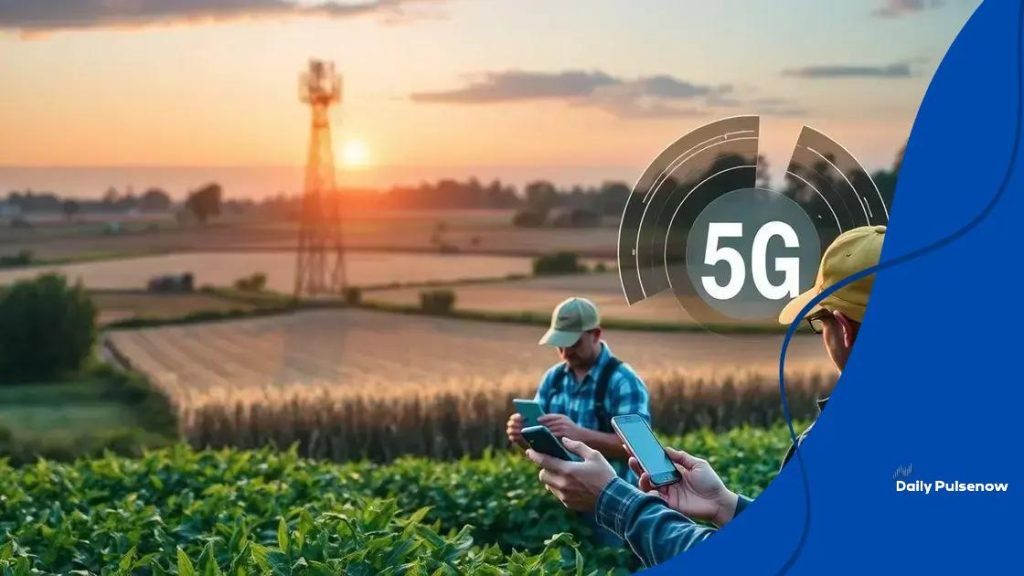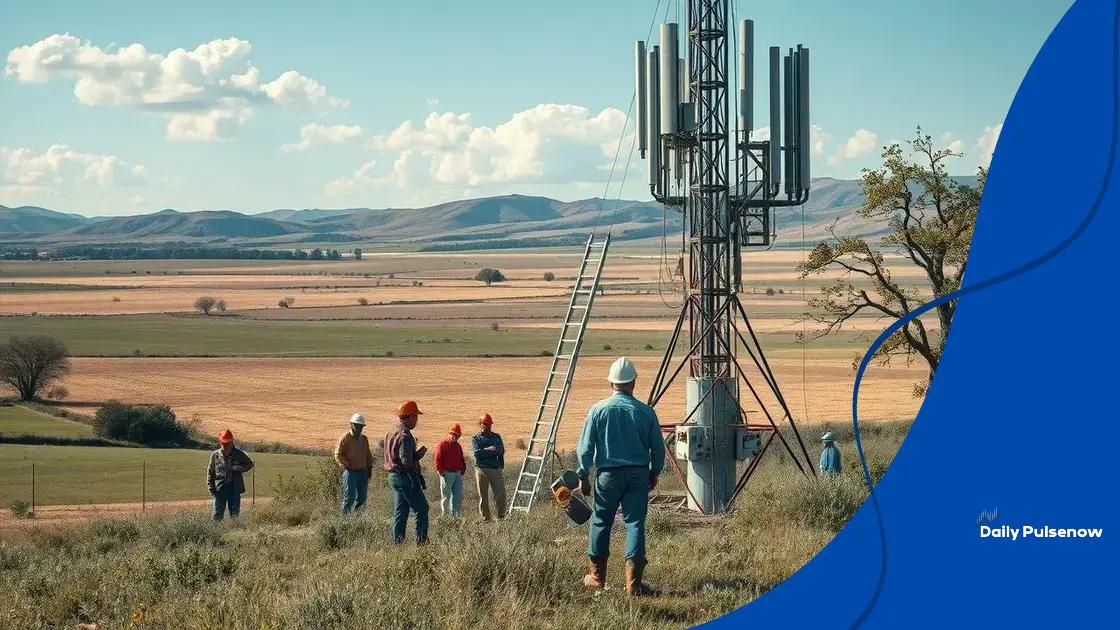The impact of 5G on rural connectivity and development

Anúncios
The impact of 5G on rural connectivity and development includes improved internet access, enhanced healthcare through telemedicine, better educational resources for students, and increased economic opportunities for local businesses.
The impact of 5G on rural connectivity and development is a topic that’s gaining traction. Have you noticed how technology has shaped our everyday lives? With 5G, rural communities can experience significant advancements in connectivity, opening the door to new opportunities.
Anúncios
Understanding 5G technology
Understanding 5G technology is essential for grasping its role in enhancing connectivity. It represents the fifth generation of mobile networks, offering speeds that are significantly faster than previous generations. This improved performance enables new applications that can transform industries, especially in rural areas.
At its core, 5G uses advanced technology to deliver a more efficient network. With lower latency and higher bandwidth, it can connect multiple devices seamlessly. This connectivity is crucial for rural areas that often face challenges in accessing high-speed internet.
Key Features of 5G
Some of the remarkable features of 5G include:
Anúncios
- Enhanced Speed: Data transfer rates can reach up to 10 Gbps, allowing for instant downloads.
- Lower Latency: Response times are reduced to just a few milliseconds, enabling real-time communication.
- Higher Capacity: 5G can support a greater number of devices per square kilometer, making it perfect for densely populated areas.
- Improved Reliability: The network is designed to provide a dependable connection, even in challenging environments.
The impact of 5G technology goes beyond just speed; it can drive innovation in various sectors, such as agriculture, healthcare, and education. For instance, remote farmers can utilize precision farming tools that require real-time data, significantly enhancing productivity.
Moreover, 5G can facilitate telehealth services, allowing patients in rural communities to consult specialists without traveling long distances. This technology also paves the way for improved educational resources, providing students with access to online learning tools and content that was previously unavailable.
As we delve deeper into the capabilities of 5G, it’s clear that its potential to revolutionize connectivity in rural areas is immense. Each advancement brings unique opportunities for communities to thrive in a digital world.
Benefits of 5G in rural areas
The benefits of 5G in rural areas are wide-ranging and impactful. This technology brings about transformative changes that can significantly improve the quality of life for residents. With faster internet speeds and enhanced connectivity, rural communities can bridge the gap with urban areas.
One major benefit is improved access to high-speed internet. This allows residents to engage in online education and telecommuting, making it easier to pursue job opportunities without relocating. In addition, farmers can employ smart farming techniques, leading to better yields and efficient resource management.
Key Advantages of 5G
Here are some noteworthy benefits:
- Enhanced Connectivity: 5G can connect multiple devices simultaneously, making it perfect for rural homes needing smart systems.
- Telemedicine Opportunities: Rural healthcare can be revolutionized with telehealth services, offering remote consultations and follow-ups.
- Economic Growth: Businesses can thrive due to better internet infrastructure, potentially attracting new companies to the area.
- Educational Resources: Students gain access to online learning tools, leveling the educational playing field.
Moreover, the implementation of 5G technology can draw investment into rural areas. This infrastructure can create jobs during the installation phase and improve the local economy. Communities can access productivity-enhancing tools, leading to overall economic diversification.
As 5G networks expand, local businesses will benefit from enhanced communication capabilities. This means faster transactions and better customer service experiences. For example, restaurants can streamline orders and manage deliveries more efficiently, enhancing customer satisfaction.
In summary, the advantages of 5G in rural areas present exciting possibilities for growth and development. The technology not only improves connectivity but also offers essential services that can elevate the standard of living in these communities.
Challenges in implementing 5G

Implementing 5G technology comes with its own set of challenges. These hurdles can hinder the progress and accessibility of this transformative communications system. Understanding these challenges is key for communities looking to benefit from 5G.
One major challenge is the infrastructure required for 5G. Unlike previous generations, 5G uses higher frequencies that have shorter ranges. This means more cell towers need to be installed, especially in rural areas where such infrastructure is often lacking.
Key Challenges in 5G Implementation
Here are several notable obstacles:
- High Costs: Setting up the necessary infrastructure can be expensive, which may deter providers from investing in rural areas.
- Regulatory Hurdles: Navigating permits and regulations can slow down deployment times significantly.
- Geographical Barriers: Rural landscapes can present physical challenges to installing towers and ensuring coverage.
- Lack of Awareness: Some communities may not fully understand the benefits and uses of 5G, leading to resistance against new technology.
Furthermore, securing funding for such projects can be a daunting task. Without proper financial resources, the rollout of 5G may become stagnated. Local governments and telecommunications companies need to work together to find solutions.
Another difficulty lies in the potential disruption caused by construction. Installing 5G infrastructure can lead to temporary traffic and accessibility issues for local residents. These disruptions may lead to community pushback, further complicating implementation efforts.
As various issues converge, the successful launch of 5G technology requires concerted efforts and collaboration among multiple stakeholders. Overcoming these challenges will pave the way for enhanced connectivity, bringing numerous benefits to rural regions.
Real-life examples of 5G impact
Real-life examples of 5G impact showcase the transformative capabilities of this technology in various sectors, particularly in rural areas. Seeing these examples helps illustrate the substantial benefits brought by high-speed connectivity.
One remarkable case is in agriculture, where farmers are utilizing 5G technology to enhance productivity. For instance, a farm in California uses sensors connected through 5G to monitor soil health and crop conditions in real-time. This allows for precise irrigation and fertilization, ultimately leading to increased yields and reduced waste.
Transformative Use Cases
Here are several notable examples:
- Telemedicine in Rural Clinics: In parts of Texas, healthcare providers are using 5G to offer virtual check-ups. Patients can connect with specialists without traveling for hours, which improves access to healthcare.
- Smart Education Programs: Schools in rural areas are implementing online programs powered by 5G. This allows students to access educational resources and participate in virtual classes, bridging the gap between rural and urban education.
- Connected Vehicles: In Michigan, tests of connected farming vehicles using 5G have shown promise. These vehicles communicate with each other and can adapt routes based on real-time data, improving efficiency and safety.
- Emergency Response: First responders in rural regions, equipped with 5G connectivity, can share live video feeds from emergencies. This vital information allows dispatchers to assess situations quickly and allocate resources effectively.
The deployment of 5G networks is already showing significant effects in enhancing daily life. Communities that embrace this technology can look forward to improved services and economic opportunities.
These real-life examples illustrate how 5G technology is not just a buzzword but a crucial development that can change the landscape of rural living, leading to a more connected and efficient future.
Future prospects of rural development with 5G
The future prospects of rural development with 5G technology are exciting and full of potential. As this advanced network becomes more widespread, it can bring significant improvements to various aspects of rural life.
One of the main areas that will benefit is economic development. With better connectivity, local businesses can thrive by reaching new customers through online platforms. Farmers can utilize 5G to adopt smart agriculture practices, enhancing crop yields and reducing resource waste.
Transformative Opportunities Ahead
Various sectors will see improvements:
- Enhanced Education: Students in rural areas can access high-quality online education. Virtual classrooms can eliminate the learning gap between city and rural students.
- Healthcare Access: The growth of telemedicine will improve health outcomes. Patients will connect with specialists without long-distance travel, making healthcare more accessible.
- Job Creation: Infrastructure projects related to 5G will create jobs in construction, technology, and telecommunications. This can drive local economies forward.
- Sustainable Practices: Businesses can leverage 5G for data analytics, leading to more sustainable practices. For example, smarter resource management can help reduce waste.
Moreover, many rural communities will experience social benefits. With high-speed internet, families can stay connected with relatives in urban areas, fostering a sense of community. 5G can also support new applications like smart homes, enhancing the overall quality of life.
As investments in 5G technology grow, rural communities must embrace these changes. Those that adapt will likely see a significant improvement in their economic and social landscapes, making them more competitive in today’s digital age.
Conclusion:
In summary, 5G technology offers immense potential for rural areas. It can transform lives by enhancing connectivity, improving healthcare access, and boosting economic growth. As communities embrace this technology, the future looks bright. By overcoming challenges and leveraging opportunities, rural regions can thrive in the digital age.
FAQ – Frequently Asked Questions about the Impact of 5G on Rural Connectivity and Development
What are the main benefits of 5G for rural areas?
5G provides enhanced connectivity, enabling better access to education, healthcare, and economic opportunities, thus improving the overall quality of life.
How does 5G technology improve agricultural practices?
Farmers can use sensors and smart devices connected via 5G to monitor crop health in real-time, optimizing irrigation and fertilization for better yields.
What challenges do rural areas face in implementing 5G?
Challenges include high infrastructure costs, regulatory hurdles, geographical barriers, and a lack of awareness about the benefits of 5G technology.
How will telemedicine benefit from 5G in rural areas?
5G enables faster and more reliable telemedicine services, allowing patients in rural communities to consult with specialists without long travel times.